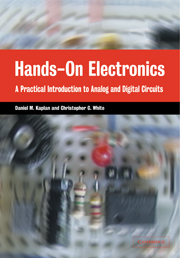Book contents
- Frontmatter
- Contents
- List of figures
- List of tables
- About the authors
- To the Reader
- Acknowledgments
- Introduction
- 1 Equipment familiarization: multimeter, breadboard, and oscilloscope
- 2 RC circuits
- 3 Diodes
- 4 Bipolar transistors
- 5 Transistors II: FETs
- 6 Transistors III: differential amplifier
- 7 Introduction to operational amplifiers
- 8 More op amp applications
- 9 Comparators and oscillators
- 10 Combinational logic
- 11 Flip-flops: saving a logic state
- 12 Monostables, counters, multiplexers, and RAM
- 13 Digital↔analog conversion
- Further reading
- Appendix A Equipment and supplies
- Appendix B Common abbreviations and circuit symbols
- Appendix C RC circuits: frequency-domain analysis
- Appendix D Pinouts
- Glossary of basic electrical and electronic terms
- Index
9 - Comparators and oscillators
Published online by Cambridge University Press: 06 July 2010
- Frontmatter
- Contents
- List of figures
- List of tables
- About the authors
- To the Reader
- Acknowledgments
- Introduction
- 1 Equipment familiarization: multimeter, breadboard, and oscilloscope
- 2 RC circuits
- 3 Diodes
- 4 Bipolar transistors
- 5 Transistors II: FETs
- 6 Transistors III: differential amplifier
- 7 Introduction to operational amplifiers
- 8 More op amp applications
- 9 Comparators and oscillators
- 10 Combinational logic
- 11 Flip-flops: saving a logic state
- 12 Monostables, counters, multiplexers, and RAM
- 13 Digital↔analog conversion
- Further reading
- Appendix A Equipment and supplies
- Appendix B Common abbreviations and circuit symbols
- Appendix C RC circuits: frequency-domain analysis
- Appendix D Pinouts
- Glossary of basic electrical and electronic terms
- Index
Summary
In this chapter you will encounter some applications of positive feedback in op amp and comparator circuits. You will see how uncontrolled feedback can cause unwanted oscillation, and how controlled positive feedback (hysteresis) can be used to eliminate unwanted oscillation or produce intentional oscillation. There is also an optional active-filter application at the end.
Apparatus required
Breadboard, dual-trace oscilloscope with two attenuating probes, two 741 and one LF411 op amp, 311 comparator, 555 timer, one 100 Ω, one 820 Ω, two 1 k, two 3.3 k, three 10 k, one 100 k, one 1 M, and one 10 M 14 W resistor, three 0.033 μF, one 0.01 μF, and one 1 μF capacitor, one red LED, and two 3.3 V Zener diodes.
Experiments
Op amp as comparator
Begin by wiring up a 741 in open-loop mode as you did in a previous lab (Fig. 9.1(a)). With no negative feedback, the saturated output that results allows the op amp to be used as a voltage comparator – a circuit that tells you whether an input voltage is higher or lower than a ‘threshold’ voltage (the threshold is ground in this case). Since op amps are not specifically engineered for open-loop operation, it is not a very good voltage comparator (in ways that we shall soon see), but in some situations (when highspeed response and high sensitivity are not required) an open-loop-741 ‘comparator’ is perfectly adequate.
- Type
- Chapter
- Information
- Hands-On ElectronicsA Practical Introduction to Analog and Digital Circuits, pp. 113 - 124Publisher: Cambridge University PressPrint publication year: 2003



